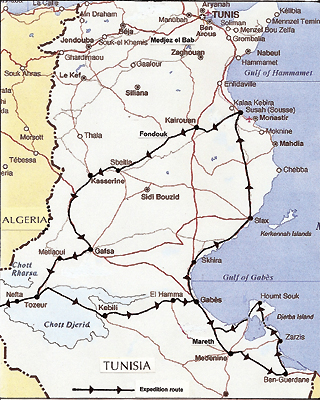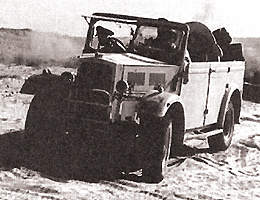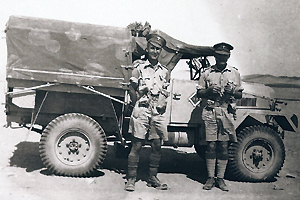|
A TRAGEDY IN TUNISIA
by Major P A J Wright OBE
formerly Grenadier Guards
|
On 8th December 1942, 3rd Battalion Grenadier Guards, having sailed from Scotland with 1st Guards Brigade, joined 1st Army in Algiers. They crossed into Tunisia and fought their first battles since leaving the beaches of Dunkirk around Medjez el Bab. These were followed by the most violent of their North African battles at Djebel Mansour in February 1943. The Brigade nicknamed ‘The Plumbers’ were called upon to plug leaks as the Germans tried to break out from encirclement. They were stopped and pursued over the Kasserine Pass towards Tunis. Complete victory came with the joining up of First Army with Eighth Army and in May with the final battle leading to the fall of Tunis.

The expedition’s route 14th-19th June 1943
|
The Battalion spent June and July at Sousse awaiting orders to embark for Italy. The heat, up to 120 degrees in the shade, was crushing and fortunately they were bivouacked under fig trees close to the sea. ‘Reveille’ was sounded at 5.30 am and training confined to the morning and evening, leaving the men free in the afternoon to sleep or bathe. The Commanding Officer, Lt Col A G W Heber Percy, a man of tireless energy and inventiveness, organised rest centres and expeditions to give his men relief from camp life.
On 14th June, with his orderly Gdsm Howland, and Driver, Gdsm Starling, he organised and personally led an expedition to revisit the battlefields and sights of Tunisia. He was accompanied by Capt A G Way with his driver, Gdsm Fox, two more drivers, Gdsm Ashton and Preston, an interpreter, Réné Helling ‘transferred’ from the French Foreign Legion and thirteen Lance Sergeants. They packed Heber Percy’s Humber ‘Box’ staff car and three 15cwt trucks with supplies the night before and started early in order to get as far as possible in the cool of the morning.
Good progress was made and, having reached Kairouan, they pushed on to Fondouk, revisiting the ground over which the Battalion had fought on 19th April. At Sbeitla they watched the Americans repairing the railway bridge and station. Fruit and vegetables were bought at the market and Helling exchanged French notes into Tunisian currency. They visited the magnificent yellow sandstone Roman remains before driving on to reach Kasserine by midday. Heber Percy described the events before, during and after the battle and they had lunch in a small French café by the side of the road. It was refreshingly cool and swallows flew in and out nesting in the ceiling.
 The Commanding Officer’s Humber ‘Box’ staff car The Commanding Officer’s Humber ‘Box’ staff car |

A Grenadier Guardsman and officer with a 15 cwt truck |
On the way to Gafsa they passed the Ferriana oasis with water running on both sides of the road and fig and olive trees for about a mile. They pushed on at speed along a tarmac road through the debris left from fighting between the Americans and Germans. Having covered 200 miles, the trucks were filled up with petrol and they washed themselves under a pump. The road deteriorated and it was relief to reach the Krill oasis with a pool of clear water, palm trees and assorted birds flying about. Half an hour later they arrived at Tozeur and were astonished to find a 50-bedroom hotel, Transatlantique, with electric lights and hot and cold water in every room. They were the first troops to visit since the end of the campaign and the contrôleur civil in turban, long robe and plus fours greeted them in the hotel courtyard. They gave their rations to the hotel and dined that night on French cuisine before retiring early.
The following morning Ashford’s truck refused to start but, after a gourmet breakfast, the remainder carried on 100 miles south to El Oued, crossing the border into Algeria. Further progress was halted by large sand dunes across the track and they returned via Nefta to Tozeur. Reunited with Ashford, and having paid the exorbitant hotel bill, they headed due east towards Kebili, soon reaching the De Gache oasis. There was a large herd of camels resting under the palm trees and another pool of clear water with small fishes in it. The whole party was refreshed and in excellent spirits.
In holiday mood, they turned south east to cross the largest salt lake in the Sahara, Chott Djerid, 60 miles long, dry and shimmering white. The staff car was in the lead travelling at speed when it struck a soft patch of salt. It was extricated and Starling, assisted by Howland, checked the carburettor, which was found to be faulty. Ashford’s truck, with four Lance Sergeants aboard, was also not running properly and he was told to push on slowly following the concrete posts that marked the route. The remainder watched as his truck disappeared into the distance when a loud explosion was heard and it was seen to be lifted high into the air before tumbling down.
When the party got to the scene, they were horrified to find Ashford’s truck upside down with bodies, clothing and equipment all round it. The horn was still blaring away and it was apparent that the truck had struck a mine. Ashford was dead as were LSgts Radley and Williams. LSgt Barker was still alive and tried to rise to his feet but fell back dead with a broken back. LSgt Rush was hardly breathing and unconscious. He was put in the staff car to be carried to the French hospital at Kebili as quickly as possible, with the other two trucks following as best they could.
The onward route became a suspected minefield and the trucks were driven some distance from and parallel to the concrete posts. On the far side of the lake Way spotted a large minefield and it took considerable time to work around it and to erect warning signs for the two following trucks. Kebili was reached at 9.00 pm that night and Rush was given morphine by a French doctor. There were no facilities to treat someone with such serious injuries and they were advised to drive to Gabes, 150 miles away.
Nearing El Hamma, they went through the battlefield of the New Zealanders and the Afrika Corps. The road was pitted with craters and there were minefields and the twisted wreckage of burnt out tanks and vehicles on both sides. Astonishingly they were halted by the Staffordshire Yeomanry doctor, whose car had broken down. He had been sent to photograph the graves of men in his Regiment. He treated Rush and gave him another dose of morphine.
Gabes was reached at midnight and Rush was admitted to the Civil Hospital where a French surgeon diagnosed a haemorrhage of the brain with no hope of recovery. Starling discovered a British casualty clearing station nearby and Rush was transferred to it by ambulance. One of the Medical Officers, Capt Schmeldt, had operated on Heber Percy’s arm when he was wounded by a mortar shell at Bou Arada. At 1.30 am, the remaining two trucks arrived and the whole party were fed and given beds. The following morning of 16th June, LSgt Williamson and Preston drove the four dead bodies back to Sousse and then on to Medjez el Bab for burial in the Battalion cemetery.
Heber Percy, known for finishing whatever he started, decide that as no more could be done for Rush, the expedition should continue. The party visited the Mareth battlefield, where 6th Battalion had suffered dreadful losses, and went on to Ben Gardane near the border with Tripolitania in order to replenish supplies. The Battalion had previously captured a strong box containing pay for the Italian Army and liras were exchanged for Tunisian currency. They then turned north to visit the island of Djerba. The ferry was a small boat, but the owner was prepared to take vehicles perilously balanced on planks. As there was a queue, the trucks were left behind and other vehicles used as transport to the Hotel de Lotus in the capital of Houmt Souk, which was reached in moonlight. Rations were handed over to be cooked with fresh fish and vegetables in the French style.
Two days of sightseeing in this peaceful town did much to restore their spirits before returning to Gabes to learn that Rush had died without regaining consciousness. Capt J G C Jameson from his company had collected his body to be buried at Medjez el Bab. On the return journey to Sousse, Fox had his windscreen torn off by a passing American dredger. Had it not been for his skilful driving those sitting behind could have been injured or killed.
They finally arrived back at camp at 8.00 pm, having covered a thousand miles. All types of terrain from the richest oases to barren desert had been seen and historic sights and battlefields visited. However, the memory of their five comrades, who were killed when spirits were at their highest, remained uppermost in all their thoughts

The Medjez el Bab War Cemetery is an oasis of peace and calm today
|
|
|


 The Commanding Officer’s Humber ‘Box’ staff car
The Commanding Officer’s Humber ‘Box’ staff car
